
You can read my story from 2020 in The American Conservative on the Donny Reynolds Jr. case here (and a follow-up). It’s the piece of work of which I’m most proud. It didn’t quite make it over the finish line in the latter days of Trump’s first term. There could be a few reasons for that. But I was invited to send it along again. I understand John Kiriakou, the whistleblower for the CIA’s torture program, has done a podcast on the case, and he’s cited my work.
I spoke to Pat Nolan today about Reynolds’ case, the conservative movement’s finest clemency wizard, and have corresponded with Pardon Attorney Ed Martin about it. Reynolds has been transferred to FCI Cumberland. It was suggested that I write up a new article explaining the case for clemency, so here it is.
I hate to make it about me, but I do feel the need to explain why I transgressed a journalistic boundary in involving myself in it. One reason is I wouldn’t have been able to live with myself if I didn’t try. Another is I felt his chances for clemency in a Republican administration were going to be better because of the allegation that Eric Holder, President Obama’s attorney general, had taken a personal interest in the case.
In general the left has an issue with taking up the case because Reynolds was a lifelong NRA member, and the right has an issue with taking up his case because Reynolds was alleged to be dealing drugs. So he falls between the cracks.
He deserves at least a commutation. After I published the story several gun rights groups reached out and they are supportive of the petition. There remains a great deal of justified distrust over the Fast and Furious scandal, which there is good reason to think Reynolds’ case is connected to—the timelines, locations, and guns at issue. Reynolds’ case would have been in the early going, before Fast and Furious got more serious.
I think this is a guy who just had to go down, and then the feds went to extraordinary lengths not just to shut him up, but also his family. The witnesses against him, a black American, appear to have been involved with a cartel, and the government’s star witness was a hitman. That’s not OK and the Trump administration should make it right. It’s also not appropriate to have put him in a CMU, which, though they were created for terrorism cases, have been abused.
There are problems with the trial itself: the main witnesses appear to have been extremely dirty, the physical evidence had chain of custody issues, IRS investigators were telling different stories to different judges. And the sentence is extremely excessive, life plus 75 years. I also obtained and published the original affidavit by his co-defendant Nathaniel Smith, denying Reynolds’ involvement with drugs. No drugs, or even residue indicating the past presence of drugs, were found in the raids on his or his parents’ houses.
Key parts of the government’s case make no sense, like the use of a historic replica tripod gun to protect drug transactions. And all of his guns were legally purchased, several of which would have required Class 3 stamps, which would have meant he was under close ATF scrutiny, and the gun store employee used as a witness was not the one he purchased most of his guns from. He possessed a Tennessee open carry permit. You would be very hard pressed to find a drug dealer whose firearms are this cognizable by law enforcement, and Reynolds was alleged to be, basically, the Scarface of Knoxville.
The whole thing looks like a stitch-up. He may have been doing business with a cartel front in Tucson, but all Reynolds’ own businesses appear to have been legitimate. And, as Reynolds said, when he declined to become an informant, the feds turned on him. As I wrote in my original piece, if he refused to participate in an operation that was running guns to cartels, and got hundreds of people killed including a border patrol officer, this is his fundamental offense from the standpoint of the machinery of law enforcement, and it also was the right decision. I still think that.



